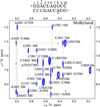Structure and thermodynamics of N6-methyladenosine in RNA: a spring-loaded base modification
- PMID: 25611135
- PMCID: PMC4405242
- DOI: 10.1021/ja513080v
Structure and thermodynamics of N6-methyladenosine in RNA: a spring-loaded base modification
Erratum in
-
Correction to "Structure and Thermodynamics of N(6)-Methyladenosine in RNA: A Spring-Loaded Base Modification".J Am Chem Soc. 2015 Jul 1;137(25):8308. doi: 10.1021/jacs.5b05858. Epub 2015 Jun 19. J Am Chem Soc. 2015. PMID: 26087989 No abstract available.
Abstract
N(6)-Methyladenosine (m(6)A) modification is hypothesized to control processes such as RNA degradation, localization, and splicing. However, the molecular mechanisms by which this occurs are unclear. Here, we measured structures of an RNA duplex containing m(6)A in the GGACU consensus, along with an unmodified RNA control, by 2D NMR. The data show that m(6)A-U pairing in the double-stranded context is accompanied by the methylamino group rotating from its energetically preferred syn geometry on the Watson-Crick face to the higher-energy anti conformation, positioning the methyl group in the major groove. Thermodynamic measurements of m(6)A in duplexes reveal that it is destabilizing by 0.5-1.7 kcal/mol. In contrast, we show that m(6)A in unpaired positions base stacks considerably more strongly than the unmodified base, adding substantial stabilization in single-stranded locations. Transcriptome-wide nuclease mapping of methylated RNA secondary structure from human cells reveals a structural transition at methylated adenosines, with a tendency to single-stranded structure adjacent to the modified base.
Figures





References
-
- Schibler U, Kelley DE, Perry RP. J. Mol. Biol. 1977;115:695–714. - PubMed
-
- Dominissini D, Moshitch-Moshkovitz S, Schwartz S, Salmon-Divon M, Ungar L, Osenberg S, Cesarkas K, Jacob-Hirsch J, Amariglio N, Kupiec M, Sorek R, Rechavi G. Nature. 2012;485:201–206. - PubMed
-
- Csepany T, Lin A, Baldick CJ, Jr, Beemon K. J. Biol. Chem. 1990;265:20117–20122. - PubMed
Publication types
MeSH terms
Substances
Grants and funding
LinkOut - more resources
Full Text Sources
Other Literature Sources
Miscellaneous

